- Submit a Protocol
- Receive Our Alerts
- Log in
- /
- Sign up
- My Bio Page
- Edit My Profile
- Change Password
- Log Out
- EN
- EN - English
- CN - 中文
- Protocols
- Articles and Issues
- For Authors
- About
- Become a Reviewer
- EN - English
- CN - 中文
- Home
- Protocols
- Articles and Issues
- For Authors
- About
- Become a Reviewer
Hydroponic Culture of ‘Micro-Tom’ Tomato
Published: Vol 5, Iss 19, Oct 5, 2015 DOI: 10.21769/BioProtoc.1613 Views: 15046
Reviewed by: Fanglian HeCindy Ast

Protocol Collections
Comprehensive collections of detailed, peer-reviewed protocols focusing on specific topics
Related protocols
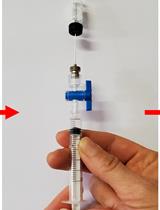
Quantification of Ethylene Production in Leaf and Bud Tissue of the Subtropical Tree Crop Litchi (Litchi chinensis Sonn.) Using Gas Chromatography and Flame Ionization Detection
Regina B. Cronje and Arnoldus J. Jonker
Mar 20, 2023 1486 Views
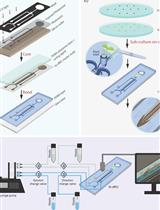
Bi-directional Dual-flow-RootChip for Physiological Analysis of Plant Primary Roots Under Asymmetric Perfusion of Stress Treatments
Claudia Allan [...] Claudia-Nicole Meisrimler
Aug 5, 2023 1832 Views
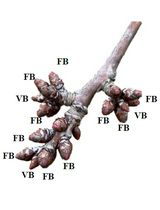
Enzymatic Starch Quantification in Developing Flower Primordia of Sweet Cherry
Nestor Santolaria [...] Afif Hedhly
Apr 5, 2025 1775 Views
Abstract
We use ‘Micro-Tom’ to study tomato fruit ripening and development mechanisms. ‘Micro-Tom’ is suitable for cultivation and experiments due to its small size of 10 to 20 cm in height and short life cycle of 3 months. There is also an abundance of publically available information on ‘Micro-Tom’ including EST, full-length cDNA clones and transcriptome data. ‘Micro-Tom’ plants are grown in hydroponic culture under fluorescents using Arabidopsis cultural shelves in greenhouses or plant rooms to get data with reproducibility for transcriptome and proteome analyses.
Keywords: TomatoMaterials and Reagents
- ‘Micro-Tom’ (Prof. Ezura and Prof. Mizoguchi of Tsukuba University, Solanum lycopersicum cv. ‘Micro-Tom’, a model plant in the Solanaceae family). ‘Micro-Tom’ is a dwarf phenotype cultivar, originally first reported of in 1989, fixed by crossbreeding Florida Basket and Ohio 4013-3 (12th filial generation) (Martí et al., 2006) (Figure 1)
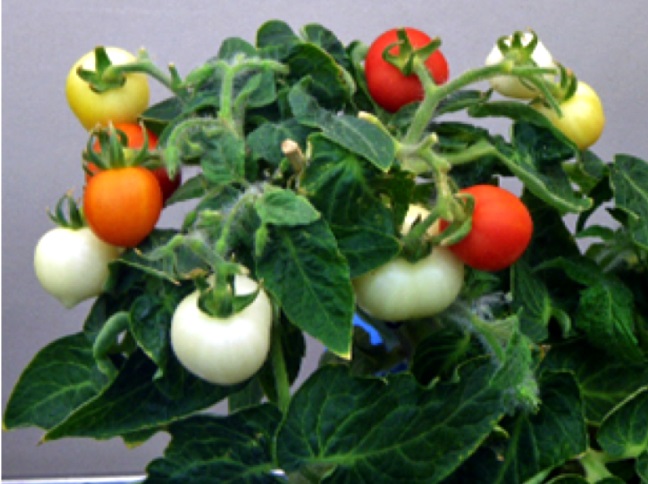
Figure 1. Solanum lycopersicum cv. ‘Micro-Tom’ - Nutrient solution [Ootsuka house 5 (OAT house 5) OATagurio Co. Ltd. 2776 (http://www.oat-agrio.co.jp/en/product/index.html)
- MS (Murashige and Skoog) mineral salts (Wako Pure Chemical Industries, Siyaku, catalog number: 392-00991 )
- Gamborg’s B-5 vitamin (Sigma-Aldrich, catalog number: G1019 )
- Sucrose (Wako Pure Chemical Industries, Siyaku, catalog number: 193-00025 )
- Agar (Bacto agar) (BD, catalog number: 214010 )
- Nutrient solution (see Recipes)
- MS (Murashige and Skoog) medium (Li, 2011) (see Recipes)
Equipment
- Rock wool (a kind of mineral wool) (A0 25/40, 25 x 25 x 40 mm) (Nitoubou Co. Ltd. catalog number: 762-090 )
- Blower (Air pump, 100 V, working pressure 0.012 MPa) (YASUNAGA CORPORATION, model: LP-30A ) (Figure 2 A)
- Three-way tube (metal 6 mm caliber) (Nissei Sangyo Corporation, catalog number: 25424 ) (Figure 2B and 2C)
- 6 mm silicon tube (bore diameter 4 mm) (Figure 2B)
- Air stone (17 x 17 x 60 mm) (Figure 2D)
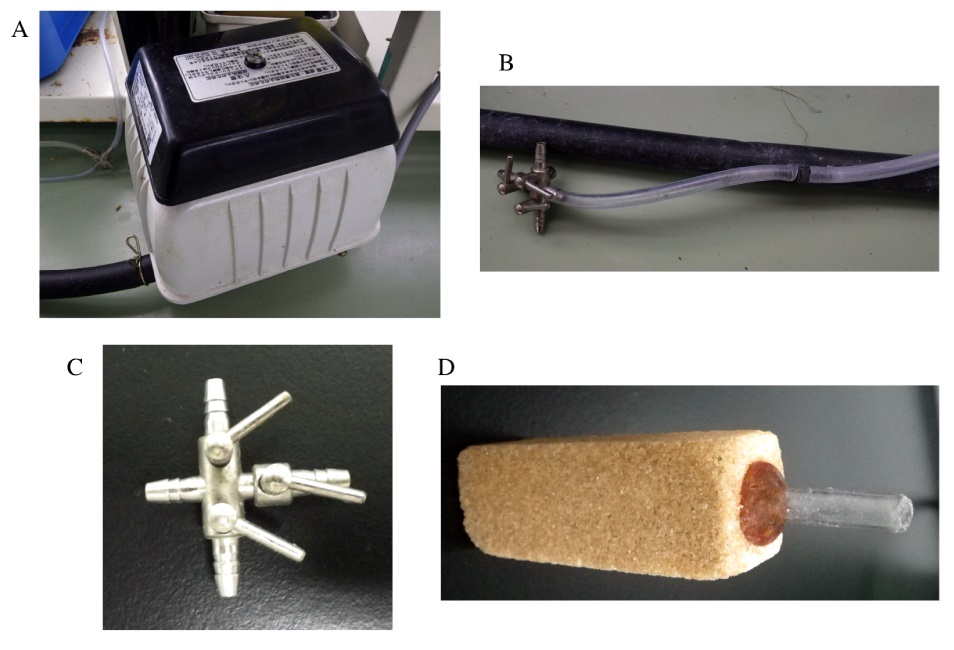
Figure 2. Parts of hydroponic culture system. A. Blower, B. 6 mm silicon tube, C. Three-way tube, D. Air stone (17 x 17 x 60 mm). - Shallow container (Size accordingly to match the scale of your project. In this case we are using a container 10 cm deep, a good example is Tupperware. We should use light-proof type of containers, because they protect to occur algae.)
- Perforated polystyrene foam board (2.5 cm thickness, 3.5 cm hole diameter, distance between holes is approximately 12 cm) (Figure 3)
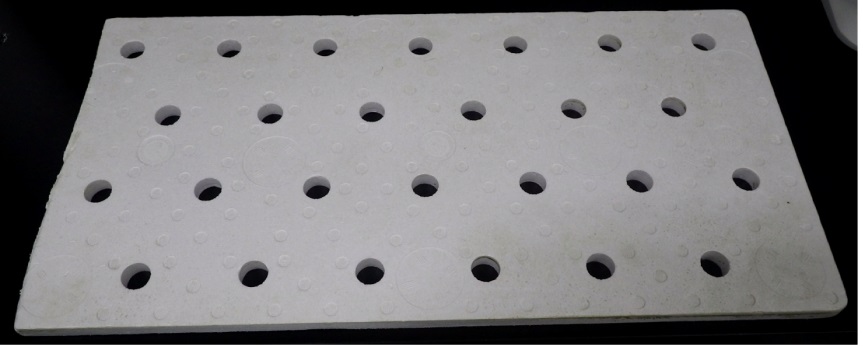
Figure 3. Perforated Polystyrene Foam Board (2.5 cm thickness, 3.5 cm hole diameter) - Plant boxes (DUCHEFA Biochemie, Steri Vent Low container, catalog number: S1682.0048 and Standard Closure lids, catalog number: S1681.0032 )
- Sponge (household daily-use type)
Procedure
- In greenhouse (Figure 4A-B)
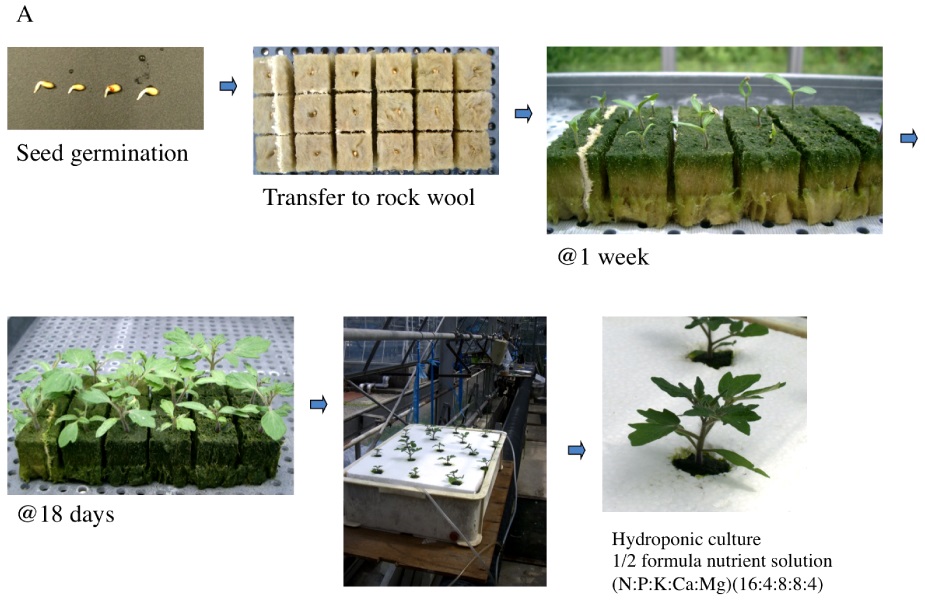
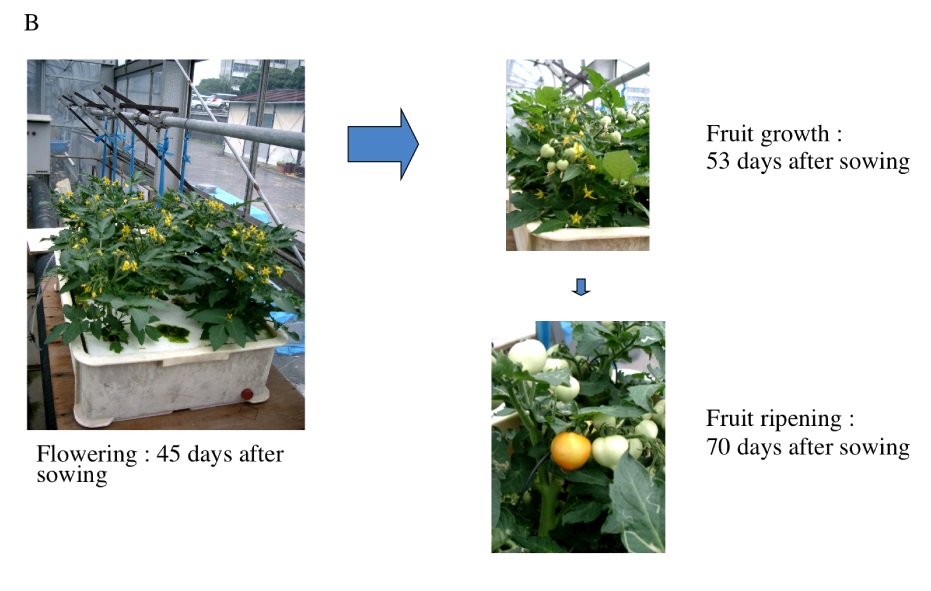
Figure 4. Growing ‘Micro-Tom’ plants using hydroponic culture. A. From seed germination to moving seedlings into hydroponic culture; B. From flowering to ripening.- Soak seeds in distilled water overnight in a shallow container to germinate (Figure 4A).
- Transfer germinated seeds to rock wool (Figure 4A).
- Grow ‘Micro-Tom’ seedlings for approximately 2 weeks (Figure 4A).
- Transfer ‘Micro-Tom’ seedlings by removing them with rock wool still attached and placing them into the holes in the polystyrene foam board (Figure 4A).
- Add 1/2 formula nutrient solution (diluted to half concentration with water) into the container (filling it to about 2/3), and use the blower to send air bubbles into the root zone of the tomato plants (Figure 5). Flowers bloom at approximately 45 days after sowing, and fruits begin to grow larger at approximately 53 days after sowing. Ripening begins at approximately 70 days after sowing (Figure 4B).
Note: By using the three-way tube, you can send air bubbles from 1 blower into multiple containers for increased efficiency. It is worth mentioning that improper air bubble supply to root zones will usually result in poor plant growth and ultimately rot symptoms. Hydroponic culture does not rot as it is constantly receiving air supply, but needs to be changed about once every 7 days (with a new nutrient solution). Polystyrene foam board that is smaller than the container may leave hydroponic culture exposed to light, which can lead to algae growth. As plant growth continues hydroponic culture will slowly be consumed, which can leave a thin air space between the polystyrene foam board and the culture, leading to problems with growth. The foam board needs to be the same size and fit well into the container, preferably with sponge/rock wool being soaked in culture.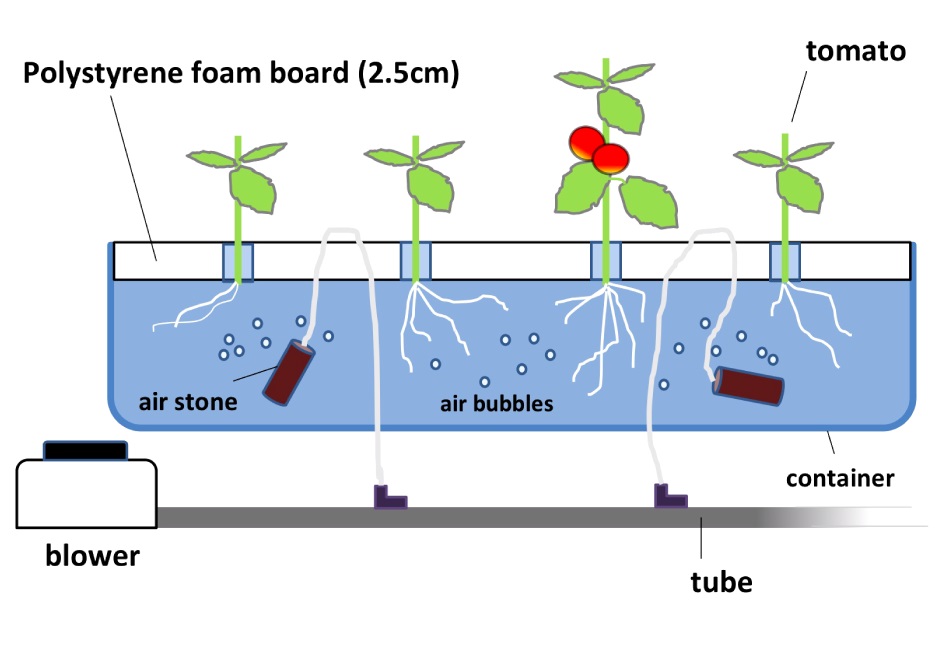
Figure 5. Hydroponic culture system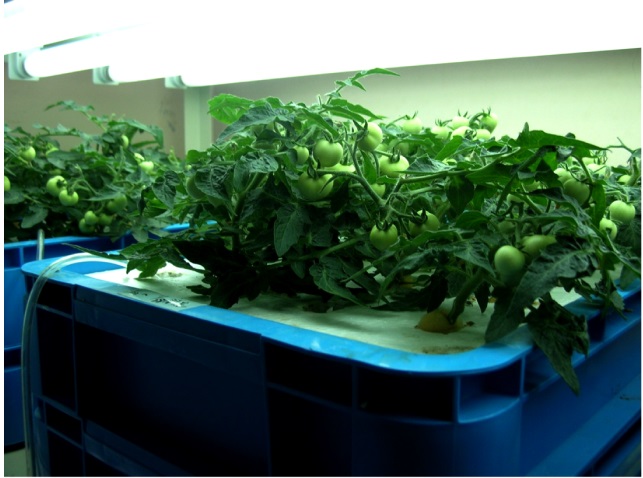
Figure 6. ‘Micro-tom’ plants are grown in hydroponic culture (16 h light/8 h dark at 26 °C)
- Soak seeds in distilled water overnight in a shallow container to germinate (Figure 4A).
- In a plant room
In addition to growth in greenhouse conditions, we also developed a protocol for hydroponic growth in a plant room (6 h light/8 h dark at 26 °C).- Sow sterilized seeds and grow ‘Micro-Tom’ plants in plant boxes (MS medium containing 2% sucrose) for 3 weeks (Figure 7) (Li, 2011).
- Extract 3-week-plants from the boxes so as not to hurt their roots (Figure 7).
- Gently wind sponge around the stems of extracted seedlings (Figure 7).
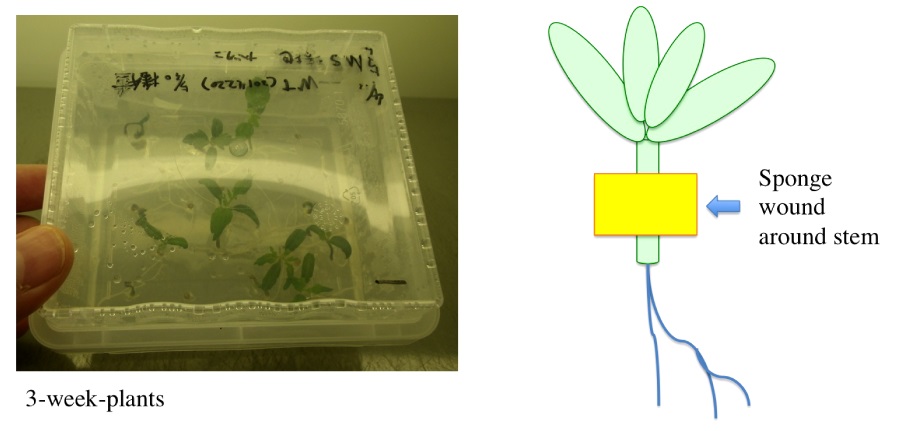
Figure 7. 3-week-plants grown in MS medium are ready to be transferred into hydroponic culture. Sponges are wound stems of seedlings and placed into holes of polystyrene foam board. - Transfer seedlings with sponge attached into the holes of polystyrene foam board (Figure 5).
- Send air bubbles to hydroponic culture using a blower in the same protocol as above (in greenhouse). Roots grow within the hydroponic culture after 2 to 3 weeks (Figure 8).
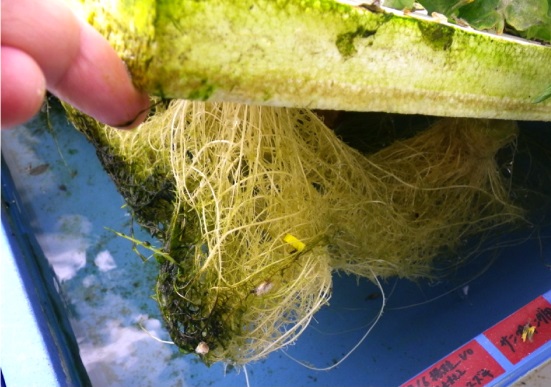
Figure 8. Roots of ‘Micro-Tom’ in hydroponic culture after 2~3 weeks
Note: Plant density per container is an important consideration, as higher density can lead to increased mildew and other problems. For a container of about 30 x 50 cm size, consider growing 15 plants or less to avoid diseases and other issues (Figures 5-6).
- Sow sterilized seeds and grow ‘Micro-Tom’ plants in plant boxes (MS medium containing 2% sucrose) for 3 weeks (Figure 7) (Li, 2011).
Recipes
- Nutrient solution
KNO3 808 mg/L
MgSO4.7H2O 492 mg/L
Ca(NO3).4H2O 944 mg/L
NH4H2PO4 152 mg/L
Microelement 50 mg/L
Mn 0.77 ppm
B 0.32 ppm
Fe 2.85 ppm
Cu 0.020 ppm
Zn 0.040 ppm
Mo 0.020 ppm - Murashige and Skoog (MS) medium
- Murashige and Skoog (MS) mineral salts
- Gamborg’s B-5 vitamin
- 2% sucrose
- 0.8% agar (Bacto agar)
- Adjust pH to 5.7 with KOH
- Murashige and Skoog (MS) mineral salts
Acknowledgments
This work was supported by the Ministry of Education, Culture, Sports, Science and Technology (Japan) [Grants-in-Aid for Scientific Research (Nos. 20510190 and 23580039 to R M)].
References
- Aoki, K., Yano, K., Suzuki, A., Kawamura, S., Sakurai, N., Suda, K., Kurabayashi, A., Suzuki, T., Tsugane, T., Watanabe, M., Ooga, K., Torii, M., Narita, T., Shin, I. T., Kohara, Y., Yamamoto, N., Takahashi, H., Watanabe, Y., Egusa, M., Kodama, M., Ichinose, Y., Kikuchi, M., Fukushima, S., Okabe, A., Arie, T., Sato, Y., Yazawa, K., Satoh, S., Omura, T., Ezura, H. and Shibata, D. (2010). Large-scale analysis of full-length cDNAs from the tomato (Solanum lycopersicum) cultivar Micro-Tom, a reference system for the Solanaceae genomics. BMC Genomics 11: 210.
- Li, X. (2011). Arabidopsis growing protocol-a general guide. Bio-protocol Bio101: e126.
- Marti, E., Gisbert, C., Bishop, G. J., Dixon, M. S. and Garcia-Martinez, J. L. (2006). Genetic and physiological characterization of tomato cv. Micro-Tom. J Exp Bot 57(9): 2037-2047.
- Suzuki, M., Takahashi, S., Kondo, T., Dohra, H., Ito, Y., Kiriiwa, Y., Hayashi, M., Kamiya, S., Kato, M., Fujiwara, M., Fukao, Y., Kobayashi, M., Nagata, N. and Motohashi, R. (2015). Plastid proteomic analysis in tomato fruit development. PLoS One 10(9): e0137266.
Article Information
Copyright
© 2015 The Authors; exclusive licensee Bio-protocol LLC.
How to cite
Readers should cite both the Bio-protocol article and the original research article where this protocol was used:
- Motohashi, R., Enoki, H., Fukazawa, C. and Kiriiwa, Y. (2015). Hydroponic Culture of ‘Micro-Tom’ Tomato. Bio-protocol 5(19): e1613. DOI: 10.21769/BioProtoc.1613.
- Suzuki, M., Takahashi, S., Kondo, T., Dohra, H., Ito, Y., Kiriiwa, Y., Hayashi, M., Kamiya, S., Kato, M., Fujiwara, M., Fukao, Y., Kobayashi, M., Nagata, N. and Motohashi, R. (2015). Plastid proteomic analysis in tomato fruit development. PLoS One 10(9): e0137266.
Category
Plant Science > Plant physiology > Plant growth
Plant Science > Plant physiology > Tissue analysis
Do you have any questions about this protocol?
Post your question to gather feedback from the community. We will also invite the authors of this article to respond.
Share
Bluesky
X
Copy link










